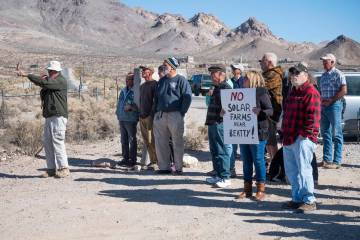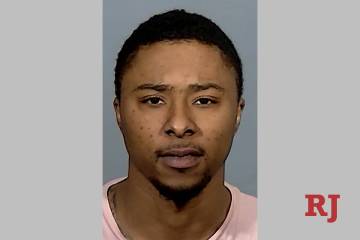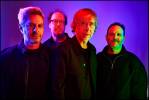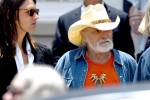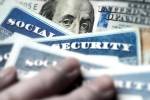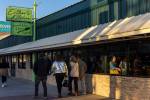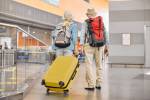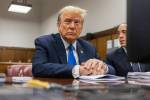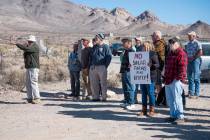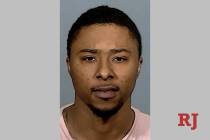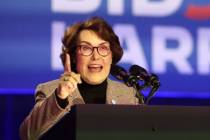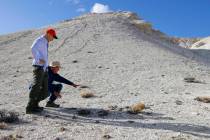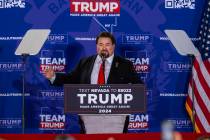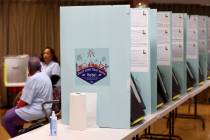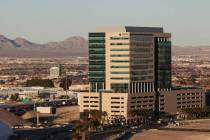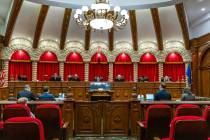A month in, how coronavirus crisis has transformed lives of Nevadans
He wrestled with the decision over three or four sleepless nights.
He talked to resort owners and associations, to labor unions, to doctors and medical experts.
He knew there would be pushback, especially from leaders in Las Vegas. The decision would upend the state’s economy overnight.
But to Gov. Steve Sisolak, there was only one option if the state was going to have a chance to slow the spread of the new coronavirus in Nevada. On March 17, Sisolak took the unprecedented step of ordering every casino and gaming operation, the lifeblood of the state’s economy, to shut down by midnight.
“I had to do what was in the best interest of Nevadans. I could not live with myself if we lost one more life as the result of keeping the Strip or downtown open,” Sisolak said in a recent interview with the Review-Journal.
It has been one month since the state’s first two cases of COVID-19, the disease caused by the new coronavirus, were reported on March 5. By Saturday, that number had climbed to more than 1,700, and the lives of 46 Nevadans had been lost.
In that time, Sisolak has ordered all K-12 schools to close, mandated that all nonessential businesses — including casinos — shut their doors, banned gatherings of 10 or more people, activated the state National Guard to assist with logistics and possibly medical duties and ordered Nevada’s roughly 3 million residents to stay in their homes except for essential reasons like grocery shopping, medical visits and exercise.
The state’s economy, which relies heavily on tourism and gaming, has ground to a near halt. Hundreds of thousands of Nevadans have lost their jobs.
And the life of nearly every Nevadan has been transformed.
December: Zero known Nevada cases
Three months before the first COVID-19 cases in Nevada, the Southern Nevada Health District received its first notification from the federal Centers for Disease Control and Prevention and international agencies of a “kind of a new pneumonia presentation in China, (and) nobody knew what this was about,” the district health officer Fermin Leguen said.
“We realized (that) we needed to start working with our community partners” to prepare, he said.
Scientists soon traced the outbreak to Wuhan, China, with the first known cases reported around December 2019. The first death caused by COVID-19 was reported on Jan. 11 in China. By Jan. 20, the U.S. had its first reported case in Washington state.
On March 2, Nevada’s chief medical officer, Ihsan Azzam, warned that it was a matter of when, not if, the disease would spread to Nevada.
“It’s a question of time when we know that it’s already community-spread in our neighboring states,” Azzam said then.
The virus was spreading in places like Washington and California’s Bay Area by then, but Nevada still lacked widespread testing to be able to detect it. By March 3, just 14 people had been tested in Nevada, according to data from the Department of Health and Human Services.
That lack of testing capacity made it difficult to know what the state was up against, said Brian Labus, an assistant professor of epidemiology and biostatistics at UNLV’s School of Public Health.
“It makes it challenging to understand exactly what’s going on, and we want to base our decisions on the reality of the situation,” Labus said.
March 5: 2 cases
Three days later, Azzam’s prediction came true.
Nevada’s first two cases of the new coronavirus were announced March 5. Both patients had recently traveled to places where the virus was spreading, and local health officials stressed that “the risk of transmission of coronavirus in Las Vegas and the country is low.”
Strict social distancing measures now in place were not yet being recommended for Nevadans. Instead, officials suggested smaller changes to social interactions like bumping elbows instead of shaking hands. Health officials also continued to stress that the vast majority of cases of the disease were mild and that most patients would recover.
Rebecca Rice, a crisis communications expert and assistant professor at UNLV’s department of communication studies, said that kind of messaging early on might have made it easy for some to brush the threat aside.
“Perhaps that message was not urgent enough to help protect the vulnerable patients,” Rice said.
The initial days after those first cases saw other issues in getting information to the public. The state health department’s website, to which officials were pointing the public for information, lagged in posting key data, including the number of people tested and the number of confirmed cases.
That, too, was a misstep, Rice said.
“The public, and I think rightfully so, is concerned when they don’t have information and they know something is happening,” she said. “People are really looking for where we are in a crisis. People are looking for where we will be. People find value in the data.”
Much of the confusion likely came from the overall governmental set up, where emergency response starts at the local level and information is shared and filtered upward, Rice said.
Adding to the challenge, she said, is that officials “often don’t know the complete picture of what you’re dealing with” because things are changing hour by hour, or even minute by minute.
March 12: 22 cases
A week after the first cases were reported, Sisolak declared a statewide emergency.
The move was partly procedural, allowing the state to access its emergency resources while also setting it up to tap into federal relief funds down the line.
But it also underscored the severity of the situation the state would soon face.
The number of confirmed cases crept upward each day. Testing capacity was still extremely limited for Nevada, and Sisolak expressed frustration that the state had not received more kits from the federal government.
The following week, life for Nevadans took several dramatic turns.
March 15: 63 cases
On March 15, Sisolak ordered all K-12 schools closed until at least April 6. By then, most of the state’s universities had already announced plans to shift to online classes.
On the same day, Nevada also reported its first death from the virus, later identified as 69-year-old Daniel Scully.
Two days later, Sisolak decided to close all casinos and gaming establishments in the state for least 30 days.
The move was unprecedented. The last time the Strip had gone dark was in 1963, when casinos shut from 7 a.m. to midnight on the day of President John F. Kennedy’s funeral.
“I know the impacts of this decision will reach far and wide into the homes and lives of our Nevada families. This was not an easy decision to make,” Sisolak said in announcing the order.
Not everyone agreed with the move. The following day, Las Vegas Mayor Carolyn Goodman urged Sisolak to shorten the closure.
“Our economy depends on tourism and being open for dining, entertainment, gaming, sports,” she told the City Council.
March 20: 124 cases
On March 20, all nonessential businesses in the state — including gyms, salons, most retail stores and more — were told to follow suit and close their doors.
Hundreds of thousands of Nevadans were furloughed or outright lost their jobs amid the closures. As in other states, Nevada’s unemployment insurance claims skyrocketed to unprecedented levels.
The economic impacts of the closures were “far-reaching and far beyond anything else we’ve seen in the state of Nevada,” said Jeremy Aguero, principal analyst for Applied Analysis.
Aguero said 320,000 jobs were “immediately at risk” in Southern Nevada’s tourism sector alone. But the greater impact is harder to predict, he added, because it’s unclear how long the public health crisis will last.
March 27: 621 cases
By late March, the number of new cases began to surge, with a fivefold increase in the span of a week. The number of deaths also accelerated, with 14 Nevadans losing their lives to the virus by March 27.
Medical supplies like protective eyewear, masks and body suits were in short supply and hard to come by, as Nevada had to compete with other states and the federal government to buy them.
Nevada’s private sector, especially resort companies, stepped in to donate massive quantities of masks, protective gear and, in some cases, even testing kits.
April 1: 1,458 cases
For two weeks, Sisolak had urged Nevadans to stay inside as much as possible in order to blunt the spread of the virus and protect the vulnerable population.
On April 1, he followed the lead of other governors and ordered residents to stay home except for essential reasons like grocery purchases, exercise and medical visits.
The same day, the governor activated 100 state National Guard troops, a move that he said will help the state collect, deliver and distribute medical supplies to health care workers across the state. Those Guard members can also be called on later to aid in critical medical care.
Sisolak’s order also extended the closures of schools, casinos and businesses through at least the end of April, a signal that the fight against the pandemic is far from its end.
Looking ahead
Labus, the UNLV epidemiology professor, said he isn’t surprised that COVID-19 gained a foothold in the U.S.
It’s the public response that’s been surprising.
“The thing that’s been really just amazing to me is just the community side of it,” he said. “The fact that the governor shut down the whole state to save lives is just amazing to me.”
In the past, individual restaurants have been shut down when there was, for example, an outbreak of norovirus that sickened thousands, said Labus. And health authorities had the option, in their “back pocket,” of shutting down an entire hotel-casino, if necessary. But there’s never been a shut-down even contemplated of anything near this scale.
Although the former senior epidemiologist at the Southern Nevada Health District has spent his career studying outbreaks, the COVID-19 pandemic is extraordinary.
“To actually live through this is a completely different experience. I don’t think anything can prepare you for that,” Labus said.
State officials and health experts say it’s still too early to know when Nevada will hit its peak in terms of cases or how bad that will be.
Some models show that the state could hit peak use of hospital resources and daily death toll about April 20. But data on the outbreak change daily, making modeling a difficult feat.
The same holds true for trying to predict the scope of the economic fallout caused by the pandemic.
Aguero, the analyst from Applied Analytics, said the models he is working on predict the economy bottoming out for around 60 to 90 days, with a roughly 18-month recovery curve to follow. But that recovery could certainly be longer because there is still so much unknown, he said.
“It’s very difficult to evaluate the economic consequences if you don’t have a sense of how the public health crisis ends,” Aguero said.
Contact Capital Bureau Chief Colton Lochhead at clochhead@reviewjournal.com. Follow @ColtonLochhead on Twitter. Review-Journal staff writers Mary Hynes and John Pryzbyz contributed to this report.




